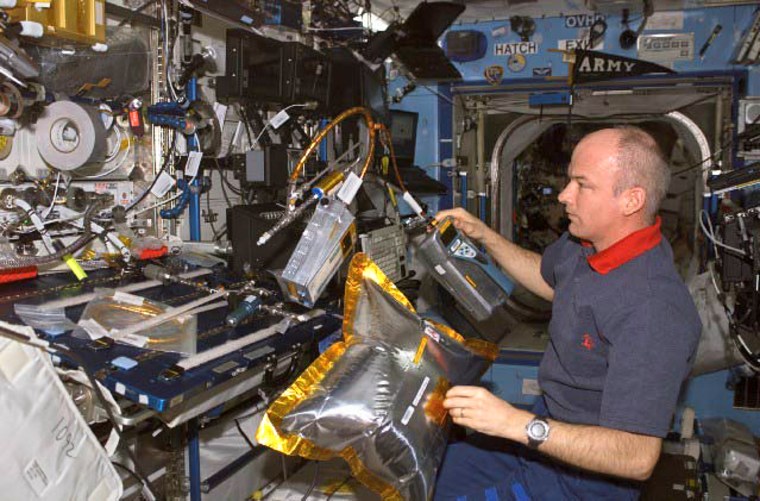When your home is an aluminum spacecraft in Earth orbit — hundreds of miles from the nearest fire station — stifling a potential fire early and fast can be a lifesaver.
A team of scientists, engineers and astronauts are working to do just that by building better detectors to pick up even the faintest wisps of smoke before a blaze erupts inside a spacecraft.
“You can’t operate a spacecraft with humans in it without having flammable materials around,” David Urban, a researcher at NASA’s Glenn Research Center who is working on the new detectors, told SPACE.com. “It’s an ongoing risk that we’re always worried about.”
That risk crystallized last month during a brief scare aboard the International Space Station, when its Expedition 13 crew reported a smoke-like smell inside the laboratory’s Russian segment.
The odor prompted ISS flight controllers to declare a rare spacecraft emergency and was ultimately traced to the leak of a mild toxic liquid– not a serious fire like that whichstruck Russia’s Mir Space Station in 1997. But the incident reinforced the value of robust detection systems not just aboard the ISS, but on all future spacecraft.
“The problem is, in all cases, they designed these [smoke] detectors just using engineering judgment,” Urban said. “[Our] goal is to provide real statistics to guide the design of future detectors for the next vehicles.”
Smoke behaves differently in space than it does on Earth. In the absence of gravity, individual smoke particles remain nearer to their source longer than their Earth counterparts and ultimately clump together to form clusters that can be 10 times bigger than terrestrial smoke particles, researchers said.
“This is important because if you’re building a smoke detector, you should know what size of smoke to look for,” Urban said.
Bulky smoke
During his six-month tour aboard the ISS, Expedition 13 flight engineer Jeffrey Williams worked with Urban and his team on the Dust and Aerosol measurement Feasibility Test (DAFT) to test handheld smoke detection devices for future orbital smoke experiments.
The experiment revolved around a handheld device dubbed P-Trak – an off-the-shelf air quality tool modified by NASA engineers for use in microgravity – which uses an internal laser and optical sensor to detect aerosols and smoke particles.
Williams combined P-Trak with a modified home ionization smoke detector, a companion dust sensor – aptly named Dust-Trak – and a four-gallon (15-liter) bag. The astronaut then shot bursts of grade-A Arizona road dust, and used the detection tools to measure the amount of material in the bag.
“We’re pretty happy with the runs we got in August,” Urban said, adding that earlier tests by ISS Expedition 10 commander Leroy Chiao successfully sampled the station’s interior atmosphere. “So now we have an idea of what the space station dust environment is.”
The space station’s atmosphere, it turns out, is relatively dust free. That’s a good thing since the presence of dust can set off the orbital laboratory’s light-scattering smoke detectors in false alarms. Finessing future spacecraft detectors to be sensitive enough to catch fires and smoke early – but not to the point that false alarms become common – will be a challenge.
“That’s a big concern,” Urban said. “The more false alarms you get the less respect your device gets both by the crew and the ground operations people.”
There are two primary smoke detectors inside the space station’s U.S.-built Destiny laboratory, though similar sensors also safeguard the Russian segments, researchers said. Smoke detectors are also installed in each laboratory rack that receives ventilation and power, they added.
The station is also equipped with carbon dioxide-based fire extinguishers in the U.S. segments and a water-foam system in the Russian modules.
“Neither has ever been used in the space station,” Urban said.
Preparing for ignition
The success of DAFT — all six hours of its operations — clears the way for an upcoming experiment in which ISS astronauts will purposely start fires in space.
Dubbed the Smoke and Aerosol Measurement Experiment (SAME), the tests call for short controlled fires to burn Teflon, Kapton tape, silicone, rubber and other spacecraft materials and then measure their resulting smoke with a P-Trak detector.
“The purpose of SAME is to gather the data that we need to determine particle size distribution for these various smokes,” said William Sheredy, NASA’s SAME project manager at Glenn, in a telephone interview.
SAME is slated to launch toward the ISS aboard a NASA shuttle in June 2007. Astronauts will install the smoke-detecting sensors and other equipment inside the station’s microgravity science glove box, and then ignite the tiny orbital fires. A shuttle smoke detector will also be included to measure its performance, researchers said.
Unlike the handheld DAFT experiment, which relied on astronaut input via a keypad, SAME is designed to function autonomously during testing runs.
“As we go to more autonomous systems we need to have a more autonomous fire detection system,” Urban said.
